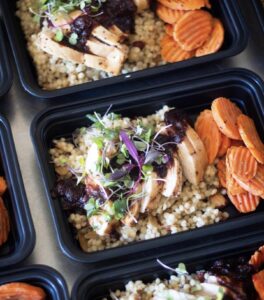This calculator helps you scale recipes up or down. The tool also creates a shopping list so you know the exact quantity of each ingredient you’ll need to buy. This tool is perfect for caterers, restaurants, and home cooks scaling recipes up or down.
Recipe Scaling Calculator
Recipe Ingredients
Recipe Scaling Results
Shopping List
How to Use the Recipe Scaling Calculator
This professional recipe scaling calculator helps you adjust recipe quantities for different serving sizes and provides a practical shopping list so you buy enough ingredients.
Basic Setup
- Recipe Name
- Enter your recipe name for reference
- Default example: “Classic Guacamole”
- Original Servings
- Enter the number of servings your original recipe makes
- Example: If your recipe serves 4, enter “4”
- Target Servings
- Enter how many servings you want to make
- Example: To serve 50 people, enter “50”
Understanding “Unit” Fields in the Calculator
Choose the most appropriate unit for each ingredient:
Each
- Use for whole items.
- Examples: avocados, limes, eggs, tomatoes
- Best for: Individual, countable ingredients.
- Calculator will always round up to whole numbers.
Cups
- Standard volume measurement.
- Examples: diced onions, chopped herbs, liquids
- Will convert to quarts when scaling to large amounts.
- Measurements shown in fractions (¼, ½, ¾) for easy reading.
Tablespoons (tbsp)
- Smaller volume measurement
- 16 tablespoons = 1 cup
- Examples: spices, herb pastes, small volume ingredients.
- Will convert to cups when scaling to large amounts.
Teaspoons (tsp)
- Smallest volume measurement.
- 3 teaspoons = 1 tablespoon.
- Examples: salt, spices, extracts.
- Will convert to tablespoons or cups when scaling to large amounts.
Piece
- Similar to “Each” but for items that can be partial.
- Examples: bell peppers, bread slices.
- Best for: Items that can be divided if needed.
How the Results are Calculated
1. Scale Factor
- Calculated as: Target Servings ÷ Original Servings
- Example: 50 servings ÷ 4 servings = 12.5x scale factor
2. Ingredient Scaling
- Each ingredient amount is multiplied by the scale factor
- Example: 2 avocados × 12.5 = 25 avocados
3. Unit Conversions
The calculator automatically converts units to more practical measurements when scaling up:
- Teaspoons → Tablespoons (when ≥ 3 tsp)
- Tablespoons → Cups (when ≥ 16 tbsp)
- Cups → Quarts (when ≥ 4 cups)
4. Batch Recommendations
- Based on manageable batch sizes of 25 servings
- Example: 50 servings = 2 batches recommended
- This helps maintain quality and consistency in preparation.
Getting the Best Results with the Recipe Scaling & Food Cost Calculator
When using this tool, attention to detail is key to making sure your recipes scale accurately and cost calculations are precise. Let’s use the Guacamole recipe as an example to highlight what you should keep in mind when inputting your data and interpreting the results.
1. Input Accuracy
To get the most accurate results, you must be precise with your inputs.
Use precise measurements from your original recipe
For example, if your guacamole recipe calls for 4 avocados and 1 teaspoon of salt, make sure to input these exact amounts. Precise measurements ensure the scaled-up or scaled-down versions of the recipe remain consistent.Choose the most appropriate unit for each ingredient
Avocados should be measured as “Each” since they are whole items, while ingredients like lime juice or diced onions should be measured in tablespoons or cups for better accuracy.Include prep notes for clear instructions
If your recipe has specific preparation steps, such as chopping tomatoes or mincing garlic, include those notes with the ingredients. This keeps the scaled recipe instructions clear and easy to follow.
2. Large Batch Considerations
When scaling recipes up for large events or catering, it’s important to keep equipment and preparation space in mind.
Follow batch size recommendations
If you’re scaling the guacamole recipe up from 4 servings to 40, consider how you will prepare such a large batch. Can your kitchen equipment handle 40 avocados at once? It might make sense to split the guacamole into two or three separate batches.Consider equipment capacity
Large batches of guacamole will require larger bowls, mixers, or preparation tools. Make sure you have the capacity to store and mix all the ingredients in one go.Check that scaled amounts fit your preparation space
For example, scaling guacamole for 100 servings could mean using 100 avocados, which takes up considerable space. Make sure your prep area can accommodate both the ingredients and the tools required to handle such a large volume.

Scaling a Cherry Balsamic Rhubarb Chicken recipe for a catering event.
3. Unit Selection
Choosing the correct unit for each ingredient is essential for scaling to work effectively.
Use “Each” for whole items that can’t be divided
For ingredients like avocados or limes, use the “Each” unit. For example, if your original guacamole recipe uses 4 avocados, the calculator will adjust this number based on the number of servings you input.Use “Piece” for items that can be divided
If you’re using a large onion but only need part of it, measure it in pieces. For instance, if the original recipe calls for half an onion, input it as 0.5 under “Piece.”Use volume measurements (cups, tbsp, tsp) for everything else
Ingredients like lime juice, cilantro, and salt are best measured in teaspoons, tablespoons, or cups. This ensures that when the recipe is scaled, you get accurate proportions of these smaller ingredients.
About this Calculator
I worked closely with chef and restaurateur Malcolm Bedell to update and refine the formulas and structure of the Professional Recipe Scaling Calculator. Over the past decade, Malcolm has successfully launched multiple food truck and restaurant concepts, including Ancho Honey and his latest venture, The Original Honey’s Fried Chicken Palace.

Malcolm Bedell
Malcolm brought his extensive, hands-on experience scaling recipes for different event sizes to this tool. This calculator was built to scale recipes up or down, and build straight-forward shopping list without requiring a bunch of time to learn. Malcolm’s insights were key in refining how how portion sizes are adjusted when scaling for large groups.
Related Tools:
Menu Recipe Scaling & Food Cost Calculator: This tool lets you easily scale recipes for any number of servings while accurately calculating ingredient costs and suggested retail prices.